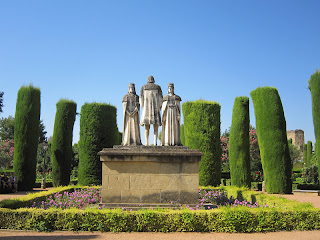Having had a great time in Granada, it was time to head back to the coast. This time to Zahara de los Atunes, a small fishing village on the Costa de la Luz just 30kms north of Tarifa on Spain's Atlantic coast. Zahara has some fantastic beaches, windswept and rugged with crystal clear waters and lovely white sand.
The village of Zahara has its own special charm with strong associations with the Atlantic Ocean. You can still see the remains of monuments dating back to the 15th Century. The Castle de las Almadrabas was built by the Dukes of Medina Sidonia to protect against invasion from pirates. More recently it was used by the Tuna fishermen for storing equipment, today it sadly lies in ruins. There are plenty of Hotels, bars and restaurants in Zahara and if you like seafood you are guaranteed to enjoy yourselves. As with Las Negras which we visited earlier on this trip, you won't find too many non Spanish voices in Zahara which means you're enjoying "real" Spain.
After a couple of lovely relaxing days on the beach at Zahara and nearby Tarifa, we hopped in our car for the drive to our next destination Cordoba. Our home for the next couple of days would be the Hotel Conquistador (check our favorites for the web address), smack bang in the middle of the old town facing onto the wonderful Mezquita. A perfect location to stay and see the city with the added benefit of an underground carpark.
 |
| Terrace area at the Hotel Conquistador |
Cordoba was founded by the Romans and due to its strategic importance as the highest navigable point of the Guadalquivir River, it became a port city of great importance, used for shipping Spanish olive oil, wine and wheat back to Ancient Rome. The Romans built the mighty bridge crossing the river, now called "El Puente Romano".
 |
| El Puente Romano |
But Cordoba's hour of greatest glory was when it became the capital of the Moorish kingdom of El-Andalus, and this was when work began on the Great Mosque, or "Mezquita", which – after several centuries of additions and enlargements – became one of the largest in all of Islam.
 |
| The Mezquita |
When the city was reconquered by the Christians in 1236, the new rulers of the city were so awed by its beauty that they left it standing, building their cathedral in the midst of its rows of arches and columns, and creating the extraordinary church-mosque we see today. The Mezquita is breath taking, an amazing mix of architecturel styles which needs to be seen to be believed.
 |
| Night shot of the Mezquita |
Next on out list to visit was the Alcazar (of the Christian Kings) features a castle its delightful gardens and a moorish bathhouse. This is a very popular monument.
A Muslim Alcazar once stood where the Episcopal Palace is today - this building was reformed in the Baroque period and was recently reconditioned in order to house the Diocesan Museum. Alongside this museum, the Exhibition Palace occupied what used to be the Church of San Jacinto and the Hospital of San Sebastian, an outstanding construction opposite the Mosque featuring a portico that stands out among the Gothic jewels in Cordoba. Inside, in the Romero de Torres hall, one can admire interesting 16th century frescoes.
 |
| Outside the Alcazar |
Despite originating from the Christian era, the Alcazar gardens are typically Moorish in design with ponds, fountains and aromatic plants. Adjacent to the gardens are the Royal Stables which extend to encompass the Gardens of the Campo Santo de los Márties.
That brings to an end our stay in Cordoba, next we hopped on the fast train (RENFE) back to Madrid to catch up with some friends and visit Toledo.
 |
| Cheers from Cordoba :-) |














No comments:
Post a Comment